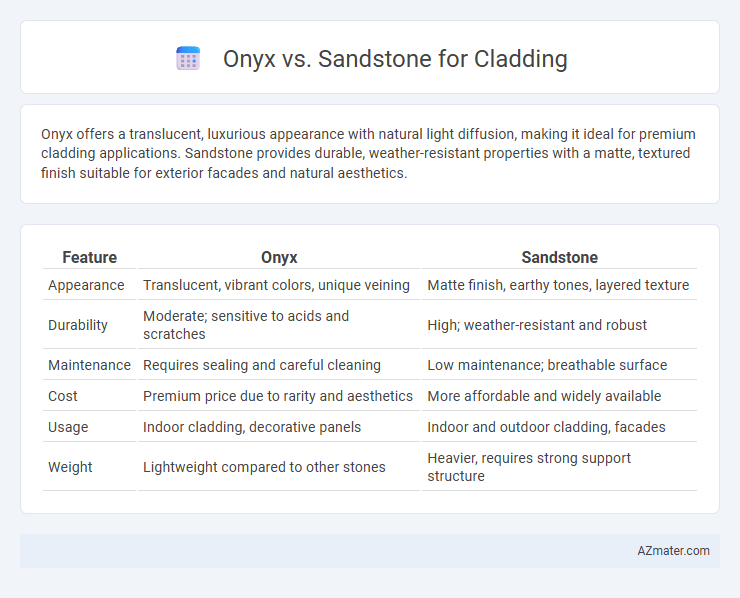Onyx offers a translucent, luxurious appearance with natural light diffusion, making it ideal for premium cladding applications. Sandstone provides durable, weather-resistant properties with a matte, textured finish suitable for exterior facades and natural aesthetics.
Table of Comparison
| Feature | Onyx | Sandstone |
|---|---|---|
| Appearance | Translucent, vibrant colors, unique veining | Matte finish, earthy tones, layered texture |
| Durability | Moderate; sensitive to acids and scratches | High; weather-resistant and robust |
| Maintenance | Requires sealing and careful cleaning | Low maintenance; breathable surface |
| Cost | Premium price due to rarity and aesthetics | More affordable and widely available |
| Usage | Indoor cladding, decorative panels | Indoor and outdoor cladding, facades |
| Weight | Lightweight compared to other stones | Heavier, requires strong support structure |
Introduction to Onyx and Sandstone Cladding
Onyx cladding offers a luxurious, translucent surface with natural veins, ideal for creating dramatic, high-end architectural features, while sandstone cladding provides a durable, textured finish with excellent weather resistance and a warm, earthy aesthetic. Onyx's unique light-transmitting properties enhance interior spaces, often used in feature walls or backlit panels, whereas sandstone is preferred for exterior facades due to its robustness and natural resistance to environmental elements. Both materials contribute distinct visual and functional qualities, making them popular choices in modern cladding applications.
Material Overview: Onyx vs Sandstone
Onyx, a translucent and luxurious natural stone, is prized for its unique veining and luminous appearance, making it ideal for decorative cladding applications where visual impact is paramount. Sandstone offers a durable, textured surface with rich earthy tones, favored for its natural slip resistance and weathering properties in exterior cladding. Both materials vary significantly in hardness, porosity, and maintenance requirements, influencing their suitability for specific architectural environments.
Aesthetic Appeal: Visual Differences
Onyx offers a translucent, glossy surface with unique veining patterns that create a striking, luxurious look ideal for feature walls and illuminated installations. Sandstone presents a matte, grainy texture with earthy tones and subtle color variations, providing a natural, rustic aesthetic suitable for exterior facades and rustic designs. Both materials enhance architectural spaces, but Onyx emphasizes elegance through light diffusion, while Sandstone highlights rugged, organic beauty.
Durability and Strength Comparison
Onyx offers stunning visual appeal but is softer and more prone to scratches and chips compared to sandstone, making it less durable for high-traffic cladding applications. Sandstone boasts excellent strength and weather resistance, with a hardness suited to withstand environmental wear and impacts over time. For long-term durability and structural resilience, sandstone is the preferred choice in exterior cladding projects where toughness is critical.
Suitability for Interior and Exterior Applications
Onyx offers a luxurious, translucent appearance ideal for interior cladding in spaces such as feature walls and backlit panels, but its softness and sensitivity to weathering limit its use outdoors. Sandstone, known for its durability and resistance to harsh environmental conditions, is highly suitable for exterior cladding, providing a natural, textured finish that withstands moisture and temperature fluctuations. For interior use, sandstone can add a rustic, earthy aesthetic, while onyx excels in creating striking visual impact where protection from physical wear and UV exposure is manageable.
Maintenance Requirements and Longevity
Onyx cladding demands more meticulous maintenance due to its softer, more porous nature, requiring regular sealing to prevent staining and damage, whereas sandstone is more durable and weather-resistant with lower upkeep needs. Sandstone's natural hardness and resistance to erosion contribute to its longer lifespan, often outperforming onyx in exterior applications exposed to harsh weather conditions. Selecting sandstone ensures reduced maintenance costs and extended durability, making it ideal for long-term cladding solutions.
Cost Analysis: Onyx vs Sandstone
Onyx cladding typically incurs higher costs due to its rarity, translucency, and complex extraction process, with prices ranging between $50 to $150 per square foot. Sandstone is more affordable, commonly priced from $10 to $40 per square foot, attributed to its abundant availability and easier quarrying methods. Maintenance and installation expenses for onyx also tend to exceed those of sandstone, impacting the overall budget considerations in architectural projects.
Environmental Impact and Sustainability
Onyx cladding, often sourced from natural stones, requires extensive quarrying processes that can lead to habitat disruption and higher carbon emissions compared to sandstone. Sandstone, being more abundant and typically quarried with less environmental disturbance, generally offers better sustainability credentials in building applications. Eco-conscious projects favor sandstone for its lower embodied energy and potential for local sourcing, reducing transportation-related emissions.
Installation Process and Challenges
Onyx cladding requires precise handling due to its translucency and fragility, demanding specialized adhesive and backlighting considerations during installation. Sandstone, being more durable and heavier, necessitates robust support structures and careful sealing to prevent moisture infiltration and weathering. Installation challenges differ as onyx slabs are sensitive to impact and require bespoke cutting tools, while sandstone poses difficulties in alignment and anchoring because of its granular texture and weight.
Final Recommendation: Choosing the Best Cladding Material
Onyx offers a luxurious, translucent appearance with high aesthetic value but requires careful maintenance due to its softness and susceptibility to scratching. Sandstone provides superior durability, weather resistance, and a natural, textured look ideal for exterior cladding in harsh environments. For long-lasting performance and minimal upkeep, sandstone is the best cladding material choice, while onyx suits high-end interiors where visual impact outweighs durability concerns.

Infographic: Onyx vs Sandstone for Cladding
 azmater.com
azmater.com